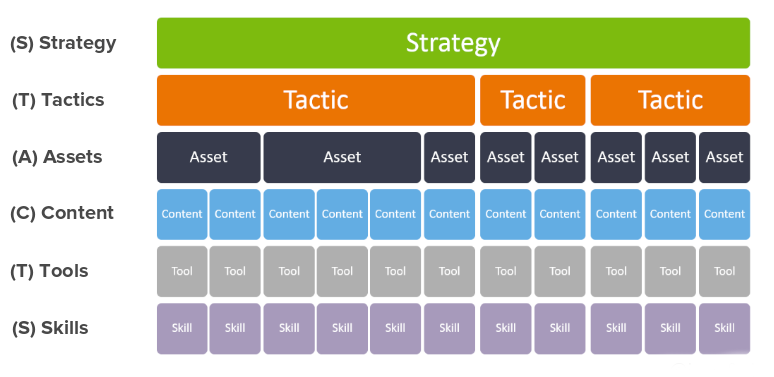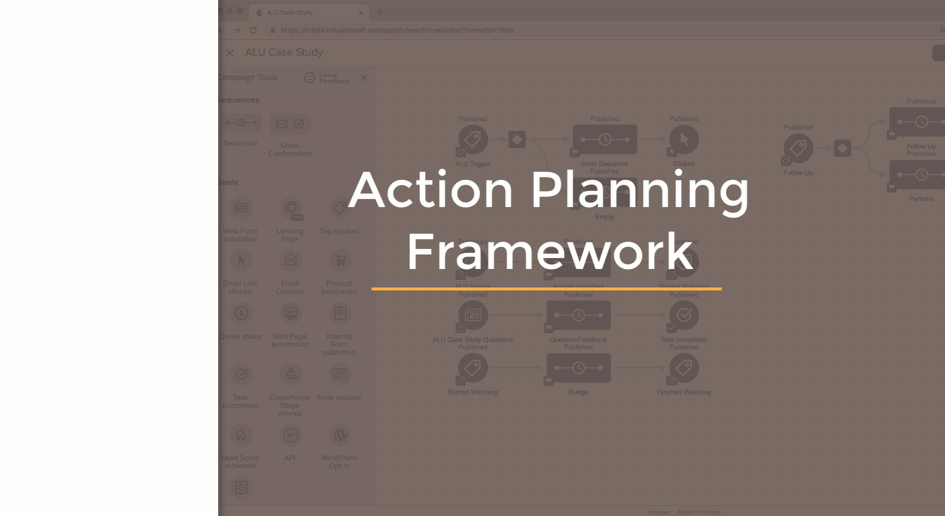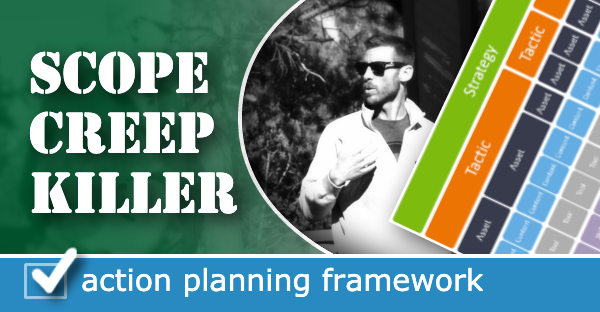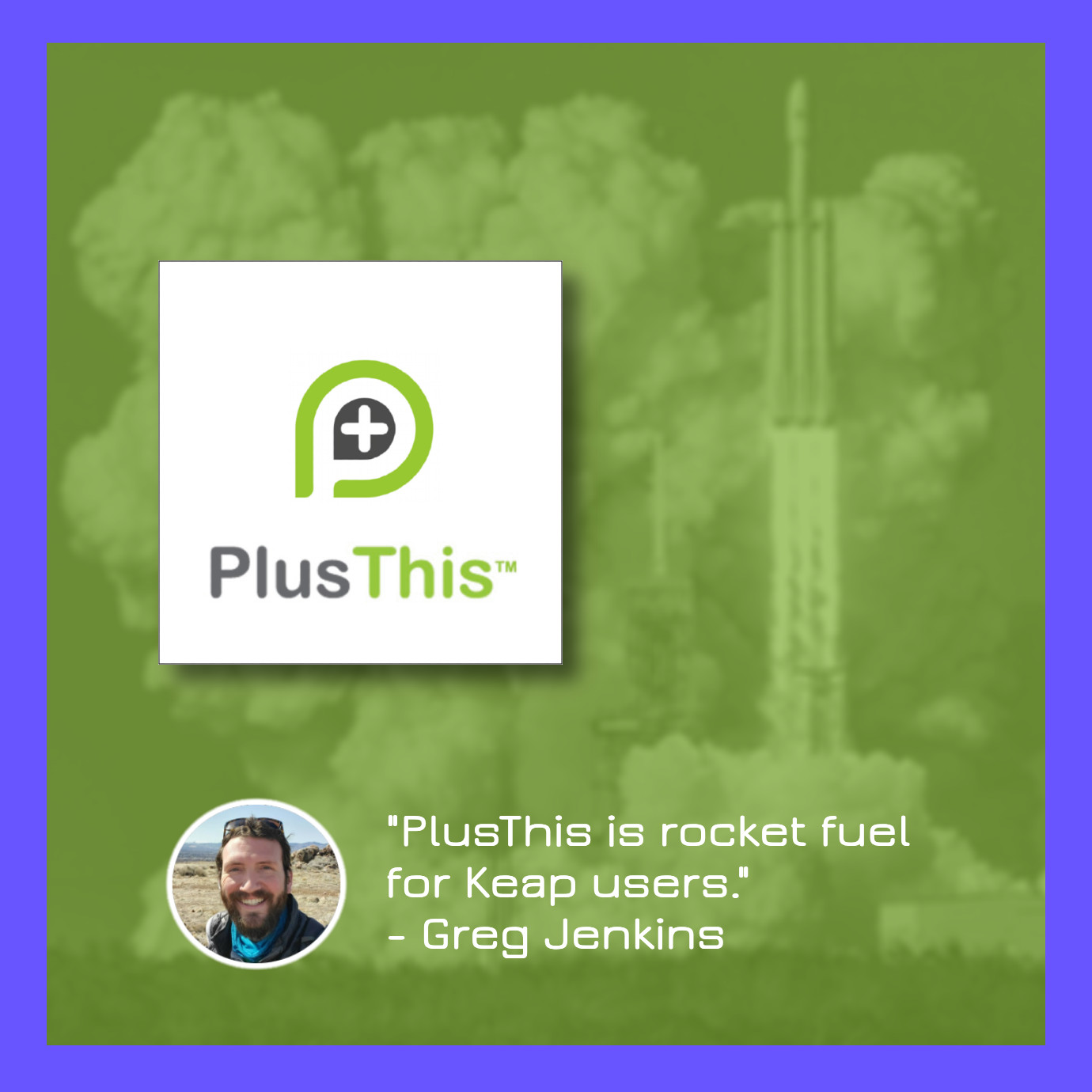This Action Planning Framework is the distillation of lessons learned from a handful of consultants across countless projects, in a variety of industries and business models.
Suffice to say, this works – time and time again.
If you have a strategy you’d like to implement, this framework will help increase the odds (and efficiency) with which it happens.
So, here’s how this works…
It starts by identifying the strategy you are trying to execute.
The strategy is the high level objective – like, book more demos, or drive new consultation appointments, increase membership free trials.
Then, you use the action planning framework to help think through the specifics for what it will take to achieve that objective.
It starts with individual tactics (launching a new ebook, hosting a webinar, deploying a JV partnership promo), and then from there it drills down into the assets required, the content needed to support those assets, the tools required to create the content, and finally the skillset(s) it wiil take to operate those tools.
This is the framework:

One important thing to note is that a particular strategy may require more than one tactic – and a particular tactic will very likely require multiple assets (a landing page, the thank you page, the follow up campaign, etc), and the same is true for content, the tools, etc.
But this framework illuminates the things that we humans tend to skip over – it forces us to ask add context and detail that could otherwise derail a project.
The Scope Creep Killer?
We’re all familiar with scope creep, right?
Ambiguity breeds scope creep – clarity crushes it.
We’ve all been there – when you think you’re almost done and realize some important element wasn’t connected – or you forgot the video for the thank you page (or the thank you page entirely).
Not anymore.
Action Planning Framework Example
Let’s look at an example: Say you want to drive new leads to your demo
Start by defining the tactic – then the assets required to support that tactic.
But then work down from each asset working through the granular details for what it will take to bring that particular element to life.

I know, that’s kind of a rushed example – but hopefully you’re seeing how this process works.
By using a systematized framework to flesh out your approach to any strategy, you’ll increase the likelihood that you get it across the finish line.
Launching things feels good, right?
And, by methodically working through the different steps required to launch something you’ll reduce the risk that something you overlooked derails things.
Lemme hand it over to my good friend Justin MacDonald to bring this one home for ya:
Pro Tip: Not everything needs to be done by you – if you’re a one-man-band it might be exhausting to work through this and realize all of the things you need to do to launch something, but the silver lining is that by organizing a project like this it makes it easier to recognize exactly what needs to be done, and the assign out the various responsibilities to the best resource for the job (which might be you, or it might be a team member, or a contractor).
Hope you found this post valuable, if you did then please give a shout out to Justin MacDonald here.
The truth is that I’ve seen far too many good ideas stall out because the details weren’t clear. This framework actively combats that and helps you get more done swiftly and confidently.
Please leave any comments or questions you have below.






Thanks for this, Greg. I love how the VISUAL approach brings greater clarity.
I’ve always used a long list of prompting questions in a Word doc I’d built up over the years to help walk me through the planning of a new strategy/promotion/etc.
But now I’ll be using that list of questions in combination with this visual process for an even better outcome.
Thanks again, Greg!
Thanks Grant – I think layering this in with your current process is a great idea. Let me know how it goes!
Love this one mate! I’ll give it a whirl and report back 👊🏻
Thanks man – let us know how it goes!
Is a template you could share?
I don’t have a specific template – because each tactic will have a different number of assets, and each asset might require a different number of content pieces, etc.
But if you follow along with the video exercise you should be able to quickly create one!
So would the get lead move into sales conversations? then into sales conversions?
Hey Clive – not sure I follow the question. Drop me a line if I can help!